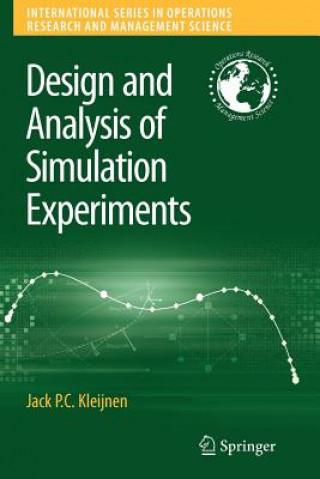
Livrare
Consilier de cumpărături





Nu se pretează? Nu contează! La noi puteți returna bunurile în 30 de zile
 Voucher cadou
orice valoare
Voucher cadou
orice valoare
Cu un voucher cadou nu veți da greș. În schimbul voucherului, destinatarul își poate alege orice din oferta noastră.
Design and Analysis of Simulation Experiments
 engleză
engleză
 400 b
400 b
30 de zile pentru retur bunuri
Ar putea de asemenea, să te intereseze


Design and Analysis of Simulation Experiments (DASE) focuses on statistical methods for discrete-event simulation (such as queuing and inventory simulations). In addition, the book discusses DASE for deterministic simulation (such as engineering and physics simulations). The text presents both classic and modern statistical designs. Classic designs (e.g., fractional factorials) assume only a few factors with a few values per factor. The resulting input/output data of the simulation experiment are analyzed through low-order polynomials, which are linear regression (meta) models. Modern designs allow many more factors, possible with many values per factor. These designs include group screening (e.g., Sequential Bifurcation, SB) and space filling designs (e.g., Latin Hypercube Sampling, LHS). The data resulting from these modern designs may be analyzed through low-order polynomials for group screening and various metamodel types (e.g., Kriging) for LHS.§Design and Analysis of Simulation Experiments is an authoritative textbook and reference work for researchers, graduate students, and technical practitioners in simulation. Basic knowledge of simulation and mathematical statistics are expected; however, the book does summarize these basics, for the readers' convenience. In addition, the book provides relatively simple solutions for (a) selecting problems to simulate, (b) how to analyze the resulting data from simulation, and (c) computationally challenging simulation problems. This is an advanced expository book on statistical methods for the Design and Analysis of Simulation Experiments (DASE). Though the book focuses on DASE for discrete-event simulation (such as queuing and inventory simulations), it also discusses DASE for deterministic simulation (such as engineering and physics simulations). The text presents both classic and modern statistical designs. Classic designs (e.g., fractional factorials) assume only a few factors with a few values per factor. The resulting input/output data of the simulation experiment are analyzed through low-order polynomials, which are linear regression (meta)models. Modern designs allow many more factors, possible with many values per factor. These designs include group screening (e.g., Sequential Bifurcation, SB) and space filling designs (e.g., Latin Hypercube Sampling, LHS). The data resulting from these modern designs may be analyzed through low-order polynomials for group screening and various metamodel types (e.g., Kriging) for LHS.§In this way, the book provides relatively simple solutions for the problem of which scenarios to simulate and how to analyze the resulting data.§The book also includes methods for computationally expensive simulations. It discusses only those tactical issues that are closely related to strategic issues; i.e., the text briefly discusses run-length and variance reduction techniques.§The leading textbooks on discrete-event simulation pay little attention to the strategic issues of simulation. The author has been working on strategic issues for approximately forty years, in various scientific disciples--such as operations research, management science, industrial engineering, mathematical statistics, economics, nuclear engineering, computer science, and information systems.§The intended audience is comprised of researchers, graduate students, and mature practitioners in the simulation area. They are assumed to have a basic knowledge of simulation and mathematical statistics; nevertheless, the book summarizes these basics, for the readers' convenience. Simulation is a widely used methodology in all Applied Science disciplines. This textbook focuses on this crucial phase in the overall process of applying simulation, and includes the best of both classic and modern methods of simulation experimentation. This book will be the standard reference book on the topic for both researchers and sophisticated practitioners, and it will be used as a textbook in courses or seminars focusing on this topic.
Informații despre carte
 engleză
engleză




 Cum să cumpăr
Cum să cumpăr






























